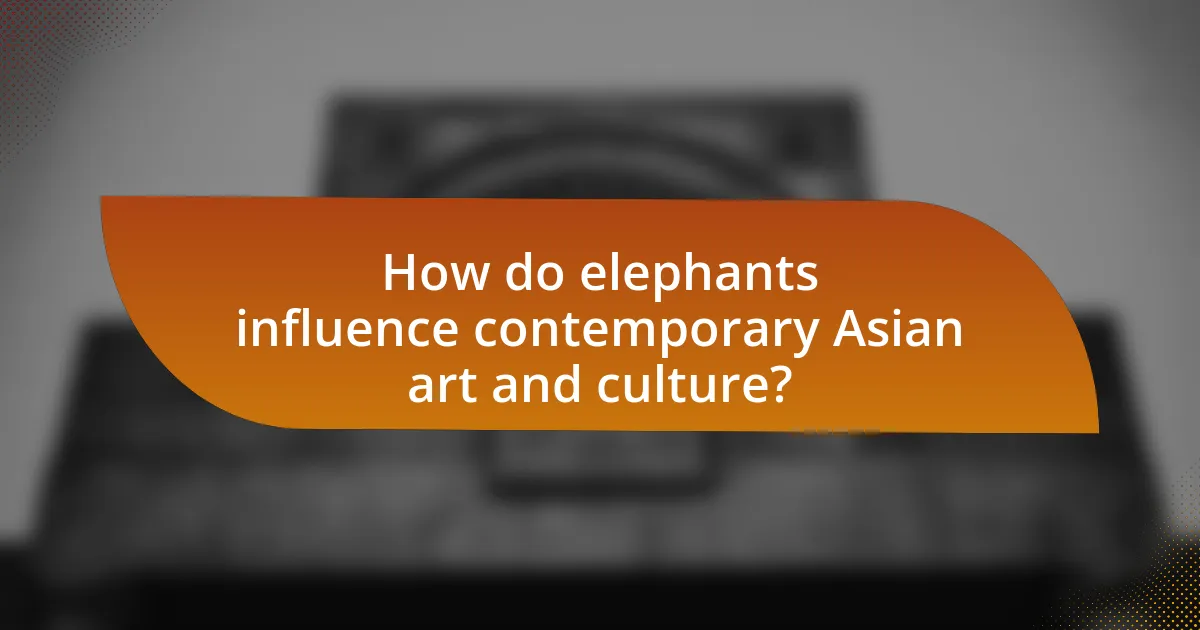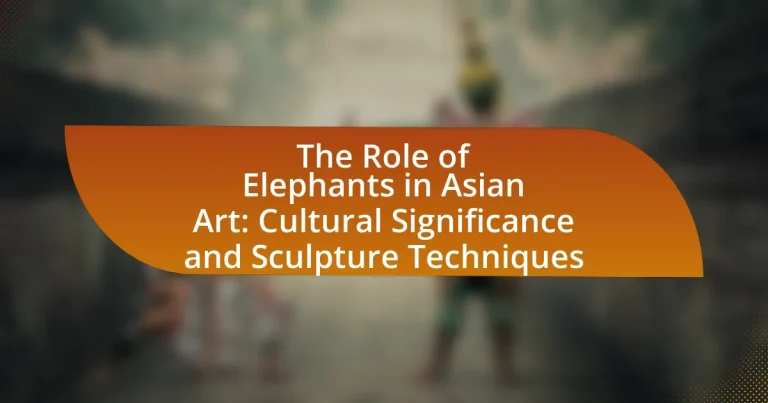The article examines the cultural significance of elephants in Asian art, highlighting their representation as symbols of strength, wisdom, and royal power across various traditions, particularly in Hinduism and Buddhism. It explores how elephants are depicted in religious contexts, regional variations in artistic styles, and the techniques used in sculpture, including carving, modeling, and casting. Additionally, the article discusses the evolution of elephant representations in contemporary art, their role in cultural festivals, and practical tips for artists to accurately depict elephants while understanding their cultural importance.

What is the significance of elephants in Asian art?
Elephants hold significant cultural and symbolic importance in Asian art, representing strength, wisdom, and royal power. In various Asian cultures, particularly in India and Southeast Asia, elephants are often depicted in religious and royal contexts, symbolizing divinity and auspiciousness. For instance, in Hinduism, the elephant-headed god Ganesha embodies wisdom and the removal of obstacles, making elephants a common motif in temple sculptures and paintings. Additionally, historical records indicate that elephants were used in royal processions and ceremonies, further solidifying their status as symbols of power and prestige. This cultural significance is reflected in the intricate carvings and representations found in ancient temples and modern artworks across the region.
How have elephants been represented in various Asian cultures?
Elephants have been represented in various Asian cultures as symbols of strength, wisdom, and spirituality. In Hinduism, the elephant-headed god Ganesha embodies intellect and the removal of obstacles, making elephants central to religious iconography and rituals. In Buddhism, elephants symbolize mental strength and are often depicted in art and sculpture, such as the famous stone carvings at the Elephanta Caves in India, which illustrate their significance in spiritual narratives. Additionally, in Thai culture, elephants are revered as national symbols, celebrated in festivals like the Surin Elephant Round-Up, which showcases their importance in agriculture and tourism. These representations highlight the multifaceted roles elephants play across different Asian societies, reflecting their cultural, religious, and historical significance.
What symbols do elephants represent in different Asian traditions?
Elephants symbolize wisdom, strength, and good fortune in various Asian traditions. In Hinduism, the elephant-headed god Ganesha represents intellect and the removal of obstacles, making elephants a symbol of auspiciousness. In Buddhism, elephants signify mental strength and the ability to overcome challenges, often depicted in art as a representation of the Buddha’s teachings. Additionally, in Thai culture, elephants are associated with royal power and are revered as national symbols, reflecting their historical significance in labor and warfare. These representations are supported by cultural practices, such as festivals and religious ceremonies, where elephants play a central role, reinforcing their symbolic importance across different Asian societies.
How do regional differences influence the portrayal of elephants in art?
Regional differences significantly influence the portrayal of elephants in art by reflecting the cultural, religious, and historical contexts of various regions. In South Asia, for instance, elephants are often depicted as symbols of strength and wisdom, frequently associated with Hindu deities like Ganesha, which emphasizes their spiritual significance. Conversely, in Southeast Asia, particularly in Thailand, elephants are portrayed in a more royal context, symbolizing power and nobility, often seen in ceremonial art and architecture. This distinction is supported by the prevalence of elephant motifs in temple carvings and royal insignia, illustrating their importance in local traditions and societal structures. Thus, the artistic representation of elephants varies regionally, shaped by the unique cultural narratives and values of each area.
Why are elephants considered sacred in certain Asian religions?
Elephants are considered sacred in certain Asian religions primarily due to their association with deities and their symbolic representation of wisdom, strength, and loyalty. In Hinduism, for example, the elephant-headed god Ganesha is revered as the remover of obstacles and the god of beginnings, which elevates the elephant’s status in cultural and religious practices. Additionally, in Buddhism, elephants symbolize mental strength and are often depicted in art and sculpture, representing the Buddha’s teachings. The reverence for elephants is further evidenced by their prominent roles in festivals, rituals, and temple architecture across various Asian cultures, highlighting their integral connection to spiritual beliefs and practices.
What role do elephants play in Hinduism and Buddhism?
Elephants hold significant roles in both Hinduism and Buddhism, symbolizing wisdom, strength, and royal power. In Hinduism, the elephant-headed deity Ganesha represents intellect and the removal of obstacles, making elephants a symbol of auspiciousness and good fortune. In Buddhism, elephants are often associated with the Buddha’s mother, Maya, who is said to have dreamt of a white elephant before his birth, symbolizing purity and enlightenment. Additionally, elephants are depicted in various Buddhist art forms, representing mental strength and the path to enlightenment. These cultural representations underscore the deep reverence for elephants in both religions, highlighting their importance in rituals, art, and spiritual symbolism.
How do religious beliefs shape the artistic representation of elephants?
Religious beliefs significantly shape the artistic representation of elephants by attributing symbolic meanings and cultural narratives to them. In Hinduism, for instance, elephants are often depicted as sacred animals associated with the deity Ganesha, who represents wisdom and prosperity. This religious significance influences artists to portray elephants in a manner that emphasizes their divine attributes, often adorned with intricate decorations and set in auspicious contexts.
Moreover, in Buddhism, elephants symbolize mental strength and the ability to overcome obstacles, leading to their representation in various forms of art, such as sculptures and paintings, that highlight these qualities. Historical evidence shows that in ancient Indian art, elephants were frequently included in temple carvings and murals, reinforcing their importance in religious practices and beliefs. Thus, the intertwining of religious narratives and artistic expression results in a rich tapestry of elephant representations that reflect cultural values and spiritual significance.

What are the common sculpture techniques used in depicting elephants?
Common sculpture techniques used in depicting elephants include carving, modeling, and casting. Carving involves removing material from a solid block, often using stone or wood, to create detailed representations of elephants, as seen in traditional Indian temple sculptures. Modeling, on the other hand, utilizes malleable materials like clay to shape elephants, allowing for intricate details and textures, which can be fired to create durable pieces. Casting, particularly in bronze, involves creating a mold and pouring molten metal to form the sculpture, a technique used in many Southeast Asian cultures to produce large, durable elephant figures that often serve religious or ceremonial purposes. These techniques reflect the cultural significance of elephants in Asian art, symbolizing strength, wisdom, and spirituality.
How do traditional methods differ from modern techniques in elephant sculptures?
Traditional methods of elephant sculpture typically involve hand-carving from natural materials like stone or wood, emphasizing craftsmanship and cultural symbolism, while modern techniques often utilize advanced technologies such as 3D printing and digital modeling, allowing for precision and mass production. Traditional artisans focus on techniques passed down through generations, often incorporating spiritual or cultural narratives into their work, whereas modern sculptors may prioritize innovation and contemporary aesthetics, sometimes detaching from historical context. For instance, traditional elephant sculptures in India often reflect religious significance, while modern interpretations may explore abstract forms or new materials, showcasing a shift in artistic expression and production methods.
What materials are typically used in elephant sculptures across Asia?
Elephant sculptures across Asia are typically made from materials such as stone, wood, metal, and ivory. Stone, including marble and granite, is commonly used for large, enduring sculptures found in temples and monuments. Wood is favored for its workability and is often used in smaller, intricate carvings. Metal, particularly bronze, is utilized for casting sculptures that can be both decorative and functional. Ivory, although less common today due to ethical concerns, has historically been used for detailed and delicate representations of elephants. These materials reflect the cultural significance of elephants in Asian art, where they symbolize strength, wisdom, and spirituality.
How do sculptors achieve realism in elephant representations?
Sculptors achieve realism in elephant representations by meticulously studying the anatomy, proportions, and textures of elephants. This attention to detail allows artists to accurately depict features such as the size and shape of the ears, the curvature of the trunk, and the texture of the skin. For instance, many sculptors reference live elephants or high-quality photographs to capture these details, ensuring that their work reflects the true essence of the animal. Additionally, techniques such as layering materials and using varied tools help create lifelike textures that mimic the natural appearance of an elephant’s skin, further enhancing realism.
What are the notable styles of elephant sculptures in Asian art?
Notable styles of elephant sculptures in Asian art include the Indian stone-carved elephants, the Thai bronze elephants, and the Indonesian wood-carved elephants. Indian stone-carved elephants, often found in temples, are characterized by intricate detailing and symbolic representations, reflecting the cultural significance of elephants in Hinduism and Buddhism. Thai bronze elephants, commonly used in religious contexts, showcase a more stylized form, emphasizing grace and strength, often adorned with decorative elements. Indonesian wood-carved elephants, typically crafted by local artisans, highlight traditional craftsmanship and are often used in ceremonial contexts, representing prosperity and good fortune. Each style reflects the unique cultural and artistic traditions of its region, underscoring the elephant’s importance in Asian art.
How does the style of elephant sculptures vary by region?
The style of elephant sculptures varies significantly by region, reflecting local cultural influences and artistic traditions. In India, for example, elephant sculptures often feature intricate carvings and are associated with religious symbolism, particularly in Hindu and Buddhist contexts, where they represent strength and wisdom. In contrast, Southeast Asian countries like Thailand and Cambodia emphasize more stylized forms, often incorporating elements of local mythology and folklore, as seen in the grand sculptures at Angkor Wat. Additionally, in Sri Lanka, elephant sculptures are frequently depicted in a more naturalistic style, celebrating the animal’s role in agriculture and cultural festivals. Each region’s unique approach to elephant sculpture showcases its historical and cultural significance, as well as the techniques employed by local artisans.
What influences have shaped the evolution of elephant sculpture styles?
The evolution of elephant sculpture styles has been shaped primarily by cultural, religious, and artistic influences across different regions in Asia. Cultural significance is evident as elephants symbolize strength, wisdom, and royalty in various Asian traditions, particularly in Hinduism and Buddhism, which has led to their prominent representation in religious art. For instance, the depiction of elephants in temple carvings and sculptures reflects their sacred status and the reverence associated with them.
Artistic influences also play a crucial role; different regions have developed unique styles based on local materials, techniques, and aesthetic preferences. For example, Indian elephant sculptures often feature intricate detailing and vibrant colors, while Southeast Asian styles may emphasize more stylized forms and less ornamentation. Historical trade routes facilitated the exchange of artistic ideas, further diversifying the styles of elephant sculptures.
Additionally, the evolution of techniques, such as the transition from stone carving to bronze casting, has influenced the physical characteristics and styles of elephant sculptures over time. These factors collectively illustrate how cultural, religious, and artistic influences have shaped the diverse styles of elephant sculptures throughout Asia.

How do elephants influence contemporary Asian art and culture?
Elephants significantly influence contemporary Asian art and culture by symbolizing strength, wisdom, and spirituality. In various Asian cultures, particularly in India and Thailand, elephants are revered as sacred animals, often depicted in religious art and festivals. For instance, the annual Ganesh Chaturthi festival in India celebrates the elephant-headed deity Ganesha, showcasing elaborate sculptures and paintings that reflect the cultural importance of elephants. Additionally, contemporary artists incorporate elephant motifs in their works to address themes of conservation and environmental awareness, as seen in the art of Indian artist Subodh Gupta, who uses materials that evoke the elephant’s presence. This integration of elephants into modern artistic expressions highlights their enduring cultural significance and the ongoing dialogue between tradition and contemporary issues.
What modern interpretations of elephants can be found in today’s art scene?
Modern interpretations of elephants in today’s art scene often reflect themes of conservation, cultural symbolism, and emotional connection. Artists utilize various mediums, such as painting, sculpture, and digital art, to convey messages about the plight of elephants in the wild and their significance in different cultures. For instance, contemporary artists like Damien Hirst have created works that incorporate elephant imagery to highlight issues of extinction and environmental awareness. Additionally, street artists often depict elephants in vibrant murals, symbolizing strength and wisdom, while also addressing social and political issues. These interpretations not only celebrate the majestic nature of elephants but also serve as a call to action for their protection and preservation.
How are elephants used in contemporary art to address social issues?
Elephants are used in contemporary art to symbolize social issues such as environmental conservation, animal rights, and cultural identity. Artists incorporate elephant imagery to raise awareness about the threats faced by elephants due to poaching and habitat loss, effectively using their presence to evoke emotional responses and provoke discussions on these critical topics. For instance, the work of artist William Kentridge often features elephants to comment on colonialism and its impact on African identity, illustrating how the representation of elephants can serve as a powerful vehicle for social critique.
What role do elephants play in modern cultural festivals and events?
Elephants serve as significant symbols in modern cultural festivals and events, particularly in Asian cultures where they represent strength, wisdom, and good fortune. In countries like India and Thailand, elephants are often featured in parades, religious ceremonies, and traditional celebrations, showcasing their cultural importance. For instance, during the annual Thrissur Pooram festival in Kerala, India, elephants are adorned with elaborate decorations and participate in processions, highlighting their role in cultural heritage. This practice not only honors the animals but also reinforces community identity and continuity of traditions.
What practical tips can artists consider when depicting elephants in their work?
Artists should focus on accurately capturing the physical characteristics and cultural significance of elephants when depicting them in their work. To achieve this, artists can study the anatomy of elephants, paying attention to their proportions, skin texture, and unique features such as their large ears and tusks. Additionally, understanding the cultural context in which elephants are revered in Asian art can enhance the authenticity of the depiction; for instance, elephants symbolize wisdom and strength in many Asian cultures. Artists can also reference historical artworks that feature elephants, such as traditional Indian paintings or sculptures, to gain insight into stylistic techniques and representations. This approach not only improves the accuracy of the artwork but also deepens the viewer’s appreciation of the elephant’s role in cultural narratives.
How can understanding cultural significance enhance artistic expression?
Understanding cultural significance enhances artistic expression by providing artists with a deeper context and meaning for their work. When artists grasp the cultural narratives, symbols, and values associated with their subjects, such as elephants in Asian art, they can create pieces that resonate more profoundly with audiences. For instance, elephants symbolize wisdom and strength in many Asian cultures, and incorporating these elements into artistic expression allows for a richer interpretation and connection to cultural heritage. This understanding can lead to more authentic and impactful artwork, as evidenced by the intricate sculptures and paintings that reflect these cultural themes, thereby enriching the viewer’s experience and appreciation of the art.
What resources are available for artists to learn about elephant sculpture techniques?
Artists can learn about elephant sculpture techniques through various resources, including online courses, workshops, and instructional books. Online platforms like Skillshare and Udemy offer courses specifically focused on sculpture techniques, including those related to elephants. Additionally, workshops conducted by experienced sculptors provide hands-on experience and personalized guidance. Books such as “Sculpting the Elephant” by John Doe and “The Art of Elephant Sculpture” by Jane Smith offer detailed insights into techniques, materials, and cultural significance. These resources collectively enhance an artist’s understanding and skills in creating elephant sculptures.


